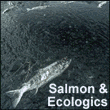forum
library
tutorial
contact

A Federal Bird Kill in the Columbia
River Did Nothing to Save Salmon
by Karina Brown
Willamette Week, February 6, 2019
|
the film forum library tutorial contact |

|
A Federal Bird Kill in the Columbia
by Karina Brown
|
"We think this goes down as one of the really significant failures in wildlife management in recent decades," Sallinger says.
"It's without question one of the worst things I've seen in my 25 years of wildlife advocacy."
 The federal government killed thousands of double-crested cormorants living on a Columbia River island between 2015 and 2017 in an effort to help young salmon make it to the Pacific Ocean alive. But Oregon state biologists say the birds just moved upriver -- possibly tripling the number of salmon each bird ate.
The federal government killed thousands of double-crested cormorants living on a Columbia River island between 2015 and 2017 in an effort to help young salmon make it to the Pacific Ocean alive. But Oregon state biologists say the birds just moved upriver -- possibly tripling the number of salmon each bird ate.
The U.S. Army Corps of Engineers killed 5,576 cormorants and destroyed 6,181 nests in an effort to prevent the birds from eating an estimated 12 million young salmon each year as they swim past East Sand Island, just east of the mouth of the Columbia as it flows into the Pacific.
Biologists say the mass slaughter may have caused the collapse of the birds' largest breeding colony. It also may have been for nothing.
James Lawonn, biologist in charge of avian predation for the Oregon Department of Fish & Wildlife, is preparing a new study on the effects of the birds' redistribution along the river. (His study was first reported by Courthouse News Service.) Lawonn says his agency "expects little to no gain in survival" from the corps' actions for young salmon swimming through the Columbia River estuary.
That's because cormorants are now living farther upriver -- still in huge numbers. And where they live makes a difference. Cormorants that live closer to the ocean choose from an extensive menu of ocean fish that form huge schools in the Columbia estuary, like anchovies, herring and smelt. Upriver, they eat a far higher proportion of salmon and other freshwater fish.
In 2017, during the bird kill, most of the colony on East Sand Island fled, in an event the Audubon Society called a "catastrophic collapse" of the largest population of double-crested cormorants in the world. The corps says there's no direct evidence to link the two events. But the mass exodus came during the corps' third year of shooting thousands of birds out of the air, destroying their nests and setting off explosives on the island.
None of the estimated 16,000 birds that fled the island in 2017 were tagged or radio-collared, so there's no data to show exactly where they went. But last year, a sudden surge in cormorants nested on the Astoria-Megler Bridge, 7 miles upriver from the island, and at other upriver spots.
The corps blames eagles for the birds' mass abandonment of the island. Kris Lightner, the corps' biologist in charge of the project's compliance with the National Environmental Policy Act, says she doesn't know whether the birds upriver came from East Sand Island.
"The management plan has been very successful in reducing the amount of salmon eaten by birds on East Sand Island," Lightner says. "We just don't know about the estuary as a whole."
ODFW says there could soon be 10,000 nesting pairs in the Columbia River estuary -- a number comparable to the original average of 12,000 pairs on East Sand Island before the corps' project. Bob Sallinger, director of conservation for the Audubon Society of Portland, says the corps' plan failed birds, fish and taxpayers.
"We think this goes down as one of the really significant failures in wildlife management in recent decades," Sallinger says. "It's without question one of the worst things I've seen in my 25 years of wildlife advocacy."
Related Pages:
Cormorant's will be killed --> State Expands Study of Salmon-eating Seabirds by Associated Press, Lewiston Tribune, 4/23/13
Salmon-Loving Seabird Causing Political Clash in Pacific Northwest by Karina Brown, Courthouse News Service, 10/2/15
Oregon: Federal Plan to Save Salmon by Killing Birds Backfired by Karina Brown, Courthouse News Service, 2/5/19
learn more on topics covered in the film
see the video
read the script
learn the songs
discussion forum
